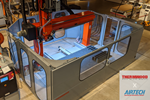Thermwood receives 32 granted additive manufacturing patents
New patents add to the company’s broad selection of already-patented LSAM equipment.

Photo Credit, all images: Thermwood Corp.
Thermwood (Dale, Ind., U.S.), which routinely applies for patent protection on additive manufacturing (AM) technology it develops for its LSAM large-format additive systems, has received all 32 official hard copy patents. The electronic copies were previously granted in 2021.
In addition to these latest patents, Thermwood points to its large portfolio of patents already issued to cover the company’s large-format 3D printer (5 x 10-foot and larger) for reliable, repeatable production of completely fused, homogeneous printed structures from a variety of fiber-reinforced thermoplastic including those intended to operate at elevated temperatures.
The LSAM technology is used in a wide variety of industries including aerospace, transportation, heavy equipment, foundry and large decorative structures. It is being used to produce a diversity of products including aerospace patterns, molds and tooling, heavy equipment foundry patterns, bus chassis, large valve body foundry patterns and trim tooling. It was even used to print what Thermwood says is the tallest 3D-printed structure in the world, the 92-foot-tall Al Davis Memorial Torch at Allegiant stadium in Las Vegas.

Thermwood LSAM equipment lineup.
Thermwood offers a broad selection of patented equipment, including single and dual gantry, fixed and moving table configurations, with both print-only and print-and-trim systems, from 5 x 10-foot to 20 x 60-foot print envelopes.
Related Content
-
Jeep all-composite roof receivers achieve steel performance at low mass
Ultrashort carbon fiber/PPA replaces steel on rooftop brackets to hold Jeep soft tops, hardtops.
-
Plant tour: Albany Engineered Composites, Rochester, N.H., U.S.
Efficient, high-quality, well-controlled composites manufacturing at volume is the mantra for this 3D weaving specialist.
-
PEEK vs. PEKK vs. PAEK and continuous compression molding
Suppliers of thermoplastics and carbon fiber chime in regarding PEEK vs. PEKK, and now PAEK, as well as in-situ consolidation — the supply chain for thermoplastic tape composites continues to evolve.








.jpg;maxWidth=300;quality=90)



